This content has been machine translated dynamically.
Dieser Inhalt ist eine maschinelle Übersetzung, die dynamisch erstellt wurde. (Haftungsausschluss)
Cet article a été traduit automatiquement de manière dynamique. (Clause de non responsabilité)
Este artículo lo ha traducido una máquina de forma dinámica. (Aviso legal)
此内容已经过机器动态翻译。 放弃
このコンテンツは動的に機械翻訳されています。免責事項
이 콘텐츠는 동적으로 기계 번역되었습니다. 책임 부인
Este texto foi traduzido automaticamente. (Aviso legal)
Questo contenuto è stato tradotto dinamicamente con traduzione automatica.(Esclusione di responsabilità))
This article has been machine translated.
Dieser Artikel wurde maschinell übersetzt. (Haftungsausschluss)
Ce article a été traduit automatiquement. (Clause de non responsabilité)
Este artículo ha sido traducido automáticamente. (Aviso legal)
この記事は機械翻訳されています.免責事項
이 기사는 기계 번역되었습니다.책임 부인
Este artigo foi traduzido automaticamente.(Aviso legal)
这篇文章已经过机器翻译.放弃
Questo articolo è stato tradotto automaticamente.(Esclusione di responsabilità))
Translation failed!
Logs
You can configure log settings to customize the output of logs that XenMobile® generates. If you have clustered XenMobile servers when you configure log settings in the XenMobile console, those settings are shared with all other servers in the cluster.
-
In the XenMobile console, click the wrench icon in the upper-right corner of the console. The Support page appears.
-
Under Log Operations, click Log Settings. The Log Settings page appears.

On the Log Settings page you can access the following options:
- Log Size. Use this option to control the size of the log file and the maximum number of log backup files kept in the database. Log size applies to each of the logs supported by XenMobile (debug log, Admin activity log, and user activity log).
- Log level. Use this option to change the log level or to persist settings.
- Custom Logger. Use this option to create a custom logger; custom logs require a class name and the log level.
To configure the Log Size options
-
On the Log Settings page, expand Log Size.
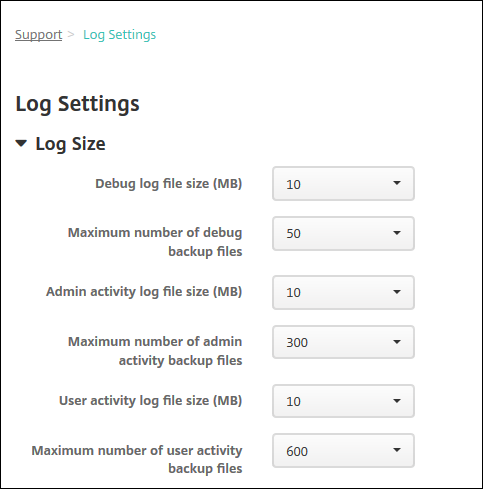
-
Configure these settings:
- Debug log file size (MB): In the list, click a size between 5 MB and 20 MB to change the maximum size of the debug file. The default file size is 10 MB.
- Maximum number of debug backup files: In the list, click the maximum number of debug files kept by the server. By default, XenMobile keeps 50 backup files on the server.
- Admin activity log file size (MB): in the list, click a size between 5 MB and 20 MB to change the maximum size of the admin activity file. The default file size is 10 MB.
- Maximum number of admin activity backup files: In the list, click the maximum number of admin activity files kept by the server. By default, XenMobile keeps 300 backup files on the server.
- User activity log file size (MB): In the list, click a size between 5 MB and 20 MB to change the maximum size of the user activity file. The default file size is 10 MB.
- Maximum number of user activity backup files: In the list, click the maximum number of user activity files kept by the server. By default, XenMobile keeps 300 backup files on the server.
To configure Log Level options
Log level lets you specify what type of information XenMobile collects in the log. You can set the same level for all classes or you can set individual classes to specific levels.
-
On the Log Settings page, expand Log level. The table of all log classes appears.
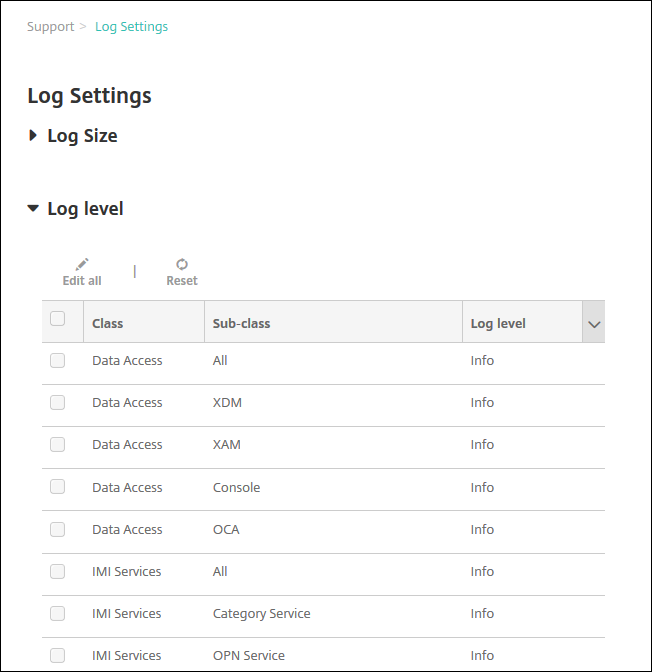
-
Do one of the following:
- Click the checkbox next to one Class and then click Set Level to change just this class’s log level.
- Click Edit all to apply the log level change to all classes in the table.
The Set Log Level dialog box appears where you can set the log level and select whether to have log level settings persist when you reboot the XenMobile Server.
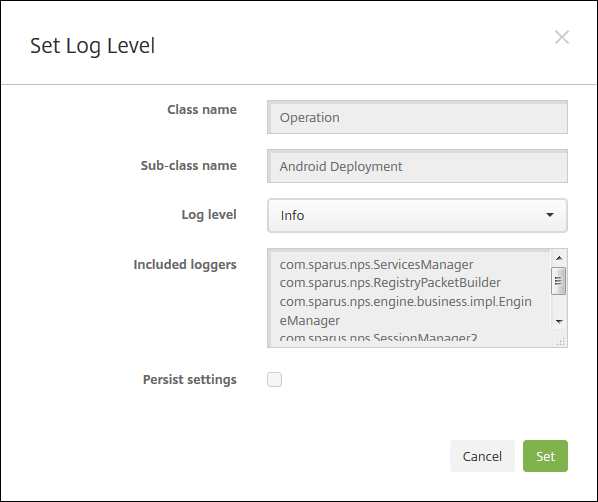
- Class Name: This field displays All when you are changing the log level for all classes or it displays the individual class name. It is not editable.
- Sub-class name: This field displays All when you are changing the log level for all classes or it displays the individual class subclass name. It is not editable.
-
Log level: In the list, click a log level. The supported log levels include:
- Fatal
- Error
- Warning
- Info
- Debug
- Trace
- Off
- Included Loggers: This field is blank when you are changing the log level for all classes or it displays the currently configured loggers for an individual class. It is not editable.
- Persist settings: If you want the log level settings to persist when you reboot the server, select this checkbox. Not selecting this checkbox means that the log level settings revert to their defaults when you reboot the server.
-
Click Set to commit your changes.
To add a Custom Logger
-
On the Log Settings page, expand Custom Logger. The Custom Logger table appears. If you haven’t added any custom loggers, the table is initially empty.
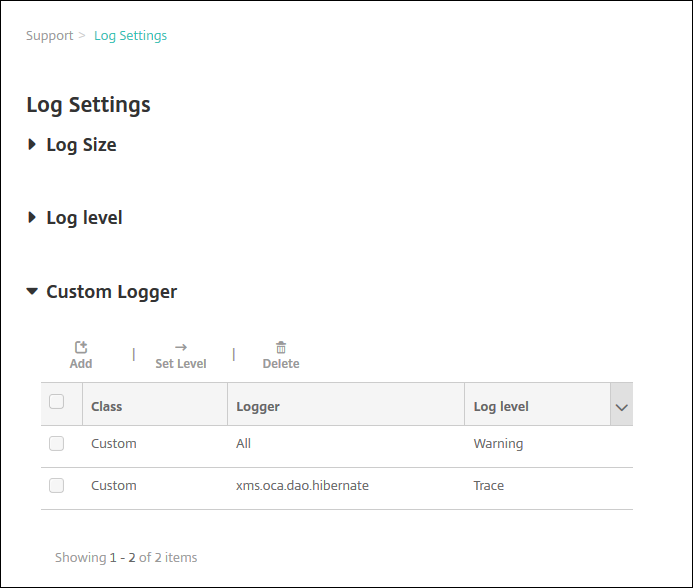
-
Click Add. The Add custom logger dialog box appears.
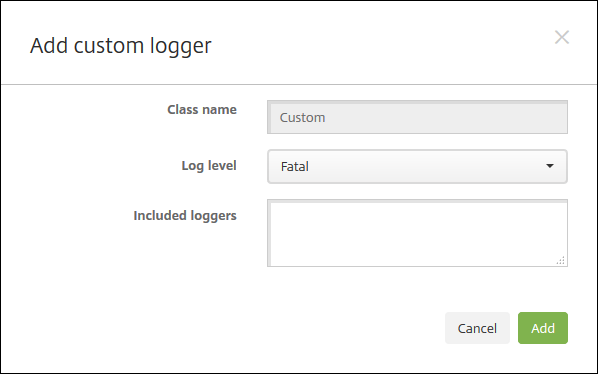
-
Configure these settings:
- Class Name: This field displays Custom. It is not editable.
-
Log level: In the list, click a log level. The supported log levels include:
- Fatal
- Error
- Warning
- Info
- Debug
- Trace
- Off
- Included Loggers: Type the specific loggers that you want to include in the custom logger or leave the field blank to include all loggers.
-
Click Add. The custom logger is added to the Custom Logger table.
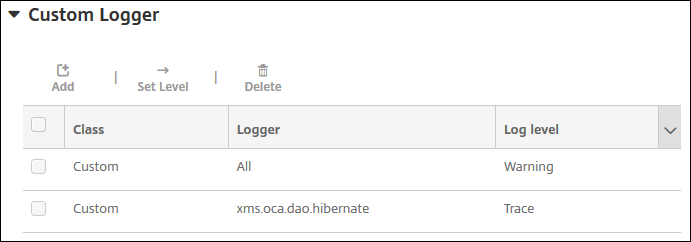
To delete a Custom Logger
-
On the Log Settings page, expand Custom Logger.
-
Select the custom logger that you want to delete.
-
Click Delete. A dialog box appears asking whether you want to delete the custom logger. Click OK.
Important:
You cannot undo this operation.
Share
Share
This Preview product documentation is Citrix Confidential.
You agree to hold this documentation confidential pursuant to the terms of your Citrix Beta/Tech Preview Agreement.
The development, release and timing of any features or functionality described in the Preview documentation remains at our sole discretion and are subject to change without notice or consultation.
The documentation is for informational purposes only and is not a commitment, promise or legal obligation to deliver any material, code or functionality and should not be relied upon in making Citrix product purchase decisions.
If you do not agree, select I DO NOT AGREE to exit.